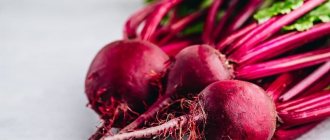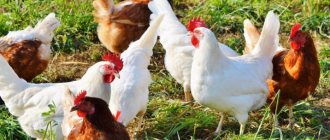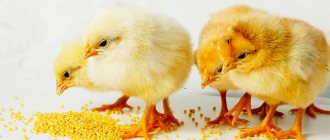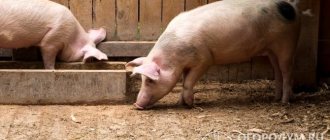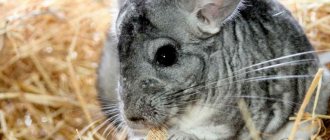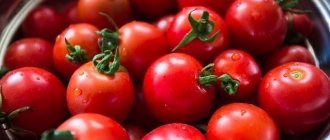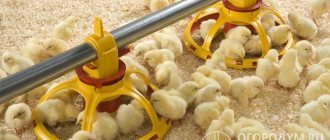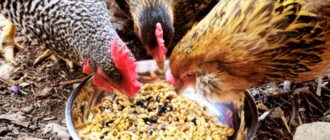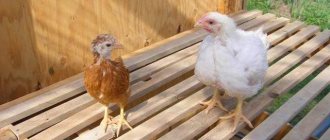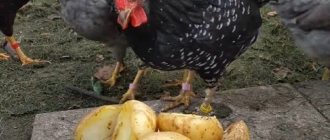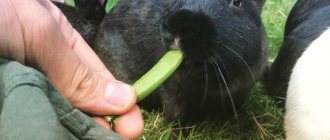Good afternoon, experienced and novice poultry farmers! In this material we will tell you what you can and cannot feed laying hens and broilers. Standard and balanced feed for feeding poultry is a given. Let's not dwell on this.
How and from what wet mash is prepared - read the link, everything is quite simple.
Today we will focus on unusual products that can be given. Only personal experience. These are not recommendations - this table is for your reference.
This is a list of almost everything you can safely feed your chicken. However, all chicks and adults have their own tiny brains full of likes and dislikes. Therefore, while some chickens may run for grapes or watermelon, chickens of a different breed or character will not react at all to the offered delicacies.
Everything on this list is definitely safe to eat and worth a try!
Is it possible to give chickens apples and use the leaves for bedding?
During the apple season, when tree branches are bursting with fruit, a novice poultry farmer has questions: is it possible to give apples to chickens, will they overeat, and are the leaves suitable for bedding? Let's go through it point by point
Chickens really love apples, and the peel and pulp are a nutritious and healthy treat. Apples contain vitamins and minerals, as well as pectin and amino acids.
If chickens have the opportunity to reach apple trees, they will try to get to the fruit. Chickens will not overeat on apples unless they are hungry. Therefore, if you provide the bird with a balanced diet, the chickens will not eat too much and will not suffer in any way, no matter what fears are written on the Internet about poultry poisoning with cyanide contained in the seeds.
Yes, the seeds contain a tiny amount of poison inside, but your chickens will never get sick from 6 to 10 seeds inside an apple. This makes it safe for birds to eat apples, including the peel and seeds. The largest amount of nutrients in apples comes from the peel, which means there is no need to peel the fruit, just cut it into slices.
If each chicken receives half a good (not rotten or moldy) apple three times a week, this will only be beneficial. Of course, the amount of apples in a chicken's diet should never exceed the amount of feed received.
An apple treat can easily be turned into a real circus show and amuse children or guests. For example, apples stuffed with sunflowers will make a splash among the chicken community. For four apples you need to take half a glass of natural unsalted peanut butter and half a glass of seeds. The seeds should be ground in a coffee grinder, mixed with peanut butter and stuffed into the apple, removing the core. Grease the top of each apple with oil and offer it to the chickens. It’s better to do this on a walk, as you will see a major league game in “chicken football.”
The second option is to make vitamin garlands from pieces of apple, beetroot, and carrot, stringing the slices on strong twine and hanging them in the chicken coop. The main thing is to remember to remove the rope later so that it does not accidentally fall under the feet of the chickens and they do not choke, mistaking the twine for a huge worm.
As for collecting fall leaves for litter, this is a common way to save money. Driving around the area in the fall, you can often see large black garbage bags filled with dry leaves. There is nothing wrong with asking owners to give them away and get free poultry material.
And if you have gardens yourself, then wait until the leaves dry out, for which you periodically stir them with a pitchfork, then collect them in bags and store them. To cover the floor in the chicken coop, you can mix dry leaves with clean straw, including for the deep litter method. After use, the leaves, turned into fertilized compost, can be easily shoveled and sent to the beds.
For nesting boxes, experienced poultry farmers advise collecting birch leaves in the fall.
In any case, dried leaves without signs of rotting are an excellent natural resource that will help keep birds warm in winter and lift their spirits when you scatter a bag of the enchanting smell of golden autumn in the coop during the cold, snowy months.
Author of the photo: Dmitry Lukyanov.
Source
How is melon beneficial for the human body?
The healing properties of melons, including melons, have been well known since ancient times.
The benefits of melon for the body and the harm possible with its thoughtless consumption were described by the greatest physician and scientist of the East, Avicenna. Today, based on the data obtained from the biochemical analysis of sweet fruits, we can talk about the use of melon and its seeds for the treatment of a wide range of human diseases. The fruits are also used as an effective prevention of atherosclerosis, colds and cardiovascular diseases, nervous disorders and genitourinary diseases.
Ancient folk recipes have survived to this day, where melon is used as a remedy against hemorrhoids and constipation, gout and other ailments. A slice of melting pulp that gives freshness helps you calm down and come to your senses after a difficult, busy day.
Without the slightest harm, melon, useful for women and men, thanks to its fiber, cleanses the intestines of harmful accumulations, activates digestive processes, and prevents cholesterol from accumulating on the walls of blood vessels. This is both an effective prevention of disorders of the gastrointestinal tract and a way to prevent heart and vascular diseases.
Compared to other crops growing on melons, melon contains significantly more ascorbic acid, which is beneficial for the body. This explains its active immunomodulatory, tonic and anti-inflammatory effect. In combination, the substances contained in the pulp cause:
- calming and invigorating effect, fatigue and irritability disappear, sleep normalizes;
- stimulation of metabolic processes, blood composition improves, which helps cope with anemia, depression and decreased performance;
- beneficial effect on the cerebral cortex.
Thanks to its choleretic and diuretic effects, melon, with benefits for the human body, can be used as a natural remedy for problems with the functioning of the kidneys and gall bladder, as well as for the risk of the formation of stones and sand. Since ancient times, the antiparasitic capabilities of melon seeds and pulp have been well studied. This culture has proven itself well as a natural anthelmintic.
The juicy pulp has a rejuvenating, tonic effect when used externally, which is why melon is beneficial for the body of women and men who take care of their appearance. The ability of melon to activate intestinal activity and facilitate cleansing of the body is used for constipation, as well as in the fight against excess weight.
Is it possible to give laying hens apples?
Apples can and should be given to laying hens; they are very useful for laying hens, as they contain many useful components. The composition includes vitamins such as C, A, E, K, B4, B9. Apples cannot do without minerals: potassium, phosphorus, calcium, magnesium, fluorine, iron. One clarification: yellow apples contain less iron than red and green ones. But yellow ones have more pectin than others.
Meat chicken
To avoid clogging the bird's stomach, causing spasms and indigestion, you should not overdo it with the amount of this fruit. Some also shared a sad story: from an excess of apples in the chickens’ diet, they began to die. Apples are considered both a healthy food and dangerous if fed incorrectly to birds.
Feeding chickens rotten apples is also not recommended. They contain a high content of putrefactive bacteria that are dangerous to the health of chickens. It is also worth remembering about cyanide, which is part of apple seeds. It's okay if the chickens eat the seeds. It's scary if they eat too much. Improper nutrition can be harmful even if the chickens live in a cage and their movements are very limited.
In order not to spoil the digestion of birds and not waste fruit in vain, it is advisable to give apples to laying hens once a week in the amount of 1 fruit per 3 birds. This way there will be no overeating. The best option is still fresh apples without seeds and with the peel cut off. It is recommended to give chickens the cake left after fruit processing.
Source
Photo
My favorite chicken treat of all is worms! Pay attention to the lightning speed when pecking, this is a reaction!
Yogurt is my hens' favorite food and it's great for gut health.
And in this photo, the chickens came running to enjoy kefir.
In the photo, a Wyandotte rooster is jumping for peanuts.
Wow! What is this? Can you eat this, is it tasty?
Here's a bowl of warm oatmeal, girls!
Warm oatmeal tastes even better after a big snowstorm.
Some leftover rice with vegetables.
Fresh and spoiled vegetables
Potato
Suitable for feeding only in boiled form.
With frequent consumption of tops and spoiled potatoes, chickens begin to get sick and soon die.
Boiled potatoes are the most important product in the diet of chickens. It is advisable to feed the bird mashed potatoes with peelings.
The root vegetable contains a significant amount of macro- and microelements, B vitamins. This vegetable is necessary for the normal growth and development of young animals. The daily norm is at least 35 grams.
Carrot
It is a useful vegetable for chickens. Rabbits love them very much. Contains b-carotene (provitamin A), vitamins B1-B6, D. It contains starch and flavonoids.
Carrots strengthen the immune system, stimulate the gastrointestinal tract, and have an antibacterial and anthelmintic effect.
One of the most loved products by birds
Raw vegetables, pre-cut into small pieces or grated, are suitable as food. You can feed chickens with carrot tops and peelings.
It is especially useful in the autumn-winter period and can replace fish oil, a source of vitamin D. The daily norm is 20 grams per individual.
In large quantities (over 35 grams per day), carrots cause diarrhea.
Cabbage
One of the most favorite products for birds. Rich in iron, calcium and magnesium.
Contains vitamins A, C, K. Normalizes the functioning of the gastrointestinal tract, reduces the accumulation of fat in the liver (due to the presence of tatranic acid). Necessary for laying hens to improve fertility.
Spoiled cabbage contains putrefactive substances and pathogens that cause intestinal diseases in the animal.
Beet
This vegetable is introduced into the diet of chickens with great care. Fodder beet contains vitamins and microelements in large quantities. Stimulates appetite, improves feed digestibility. It is actively eaten by birds.
Tubers (washed) and tops are suitable for nutrition. Beets are given raw. For one feeding there are 25-40 grams of vegetables.
Attention! Red and sugar beet varieties are not suitable for feeding chickens. They cause diarrhea and turn the cloaca purple. This causes a depressed state in the bird, provokes fights and pecking.
Radish, rutabaga
The fruits and tops of these root crops can be given in small quantities (no more than 7-10 grams). Vegetables are finely chopped and added to the mash. Experts do not recommend consuming these root vegetables in any other form.
Radish, turnip
They have substances that have a beneficial effect on the growth of chickens. They have a bitter taste. In this regard, you should mix ground root vegetables into the main food. Birds refuse to peck radish fruits.
The most important element of the diet of adult poultry and chickens. Rich in vitamin C, which is an antioxidant, stimulates the immune system, and has a detrimental effect on helminths.
Onions are the most important element in the diet of adult poultry and chickens
Onions are introduced into the diet of chickens by the end of the first week of life. It is passed through a grater and added to the mash. Onions have a pungent odor, which is why excessive amounts in food repel birds (especially chickens).
Eggplants and tomatoes
They belong to the Solanaceae family. Green eggplants and tomatoes, as well as tops, contain a lot of solanine, which is a destructive poison, and are not suitable for feeding chickens.
Add no more than 5-10 grams of ripe eggplants and tomatoes to the diet.
Cucumbers.
Fresh cucumbers are suitable as a vitamin supplement. Useful for laying hens. At first, give cucumbers cut in half, and then add whole ones. It should be remembered that overripe peels should not be given to poultry.
Pumpkin, zucchini
Healthy foods in the poultry diet. Pumpkin is rich in pectin and vitamin A, which have a beneficial effect on the functioning of the digestive organs and immunity. Before feeding, they should be finely chopped or given the pulp. The peelings are also suitable for food.
Corn
Contains a large amount of carbohydrates. Crushed corn grains are suitable for feed for complete digestion. Suitable as a supplier of energy substances in winter.
Is it possible to give bread?
The main requirement for a balanced diet for chickens is the presence of nutritional and beneficial elements such as fats, carbohydrates, minerals and vitamins. In this regard, a completely logical question arises: “Is it possible to give chickens bread?” Opinions on this matter vary greatly. The type of baking is of great importance here. If you mix bread with bran, cottage cheese, meat, herbs and potatoes, you will get a good complete food for birds. Such food will not harm the health of chickens and will have a good effect on the level of egg production. As for fresh bread, it is not recommended to give it to birds. Such a product can adversely affect the health of the chicken and also reduce immunity.
The fact is that in chicken stomachs, fresh bread swells and turns into a dense lump. This may even lead to the death of the bird. Black varieties of bread are especially dangerous. They contain salt and yeast, and also have a high level of acidity. This composition helps to activate the fermentation mechanism, which reduces egg production.
Many household owners believe that spoiled bread can be given to chickens. However, moldy baked goods can cause serious harm to birds. It can lead to poisoning and metabolic problems. To deprive moldy baked goods of the negative impact, you need to keep them in the oven.
Can any bread be given to birds? What should you not feed chickens? In no case is it recommended to give sweet buns and pastries with various fillings. This type of diet contributes to blood thickening and can lead to digestive disorders. Since white bread is also high in carbohydrates, it can only be given in the form of crackers. But even in this form, you should not be zealous with feeding. In winter, bread can be an excellent source of energy for birds. However, if chickens are kept in cages or small enclosures, it is better not to use such food. This type of food, combined with a lack of exercise, can cause blockages in blood vessels.
Fresh and spoiled fruits
What fruits can be given to chickens?
Apples, pears, plums
They contain a lot of vitamins (B1-B6, C) and microelements (iron). In large quantities they cause digestive upset.
Fresh carrion is suitable for food. 10-12 grams of chopped fruit are mixed into the main food. Such food spoils quickly and is unfit for consumption after 3-4 hours.
Rotten apples and plums contain putrefactive bacteria and are dangerous to the health of the bird. During fermentation, pears release a small amount of alcohol, which is toxic to the body.
Peach, apricot
Contains vitamins B, E, K, PP. Also mineral salts (potassium, phosphorus, zinc), organic acids (malic, quinic). Rich in fiber. Fresh pulp is suitable for consumption. Rotten fruits will cause fermentation in the intestines.
The seeds are poisonous because they contain amygdalin.
One of the favorite delicacies of chickens. They happily peck both the flesh and the seeds. In small quantities, melon is a source of vitamin C, E, PP and zinc.
Melon is one of the favorite delicacies of chickens.
In large quantities, it causes disruption of food passage and has a toxic effect on the body.
Citrus fruits (oranges, tangerines). Rich in vitamin C. However, they belong to the category of food that birds are reluctant to consume. Chickens peck at the flesh and discard the peel altogether.
Banana
Does not contain substances beneficial to poultry. And the chickens themselves are reluctant to peck its flesh. Banana peel contains dense fibers that can cause esophageal blockage and are difficult to digest.
Candied fruits, figs
They contain a large amount of sugar, which causes fermentation in the stomach. In addition, they are dense, difficult to digest, and clog the gastrointestinal tract.
Unripe figs contain caustic milky juice and are therefore poisonous.
The berries are fresh and not very
Currants, blueberries.
Rich in vitamin C, microelements, flavonoids, tannins.
Currants increase the pH of the stomach to the alkaline side, due to which it has an antimicrobial effect. Removes waste and toxins. Contains a large amount of folic acid, which increases fertility.
It is not recommended to give chickens and laying hens a lot of blueberries - they contain a high content of tannins, which slow down peristalsis.
Raspberries, blackberries.
Contains vitamins B, A, PP, micro- and macroelements (potassium, iron). As well as organic fatty acids and substances that lower the level of fat in the liver.
In large quantities they cause digestive disorders and impair egg production.
Watermelon.
Watermelon pulp and seeds contain vitamins B1, B2, PP. As well as provitamin A, folic acid, carotenoids, microelements (manganese, potassium, iron). Stimulates digestion and metabolism processes. Strengthen the immune system.
Poultry farmers are often interested in whether it is possible to give watermelon rinds to chickens. They are not harmful to the bird. They have a high content of vitamin E (tocopherols), which increases egg production and is an antioxidant.
Finely chopped peels should be given
Finely chopped peels should be given. Chickens are reluctant to peck large pieces of them.
Other berries
Strawberries, wild strawberries, and grapes are rich in vitamin C. Due to the high sugar content, they activate fermentation processes and promote the development of pathogenic microorganisms. They are given in small quantities.
Gooseberries and rowan in small portions are excellent suppliers of nutrients.
All berries contain hydrocyanic acid, which in large doses causes severe poisoning. It is necessary to avoid stale and spoiled foods in the diet.
Greenery
An irreplaceable feed in the diet of chickens, especially laying hens. In summer, the feed mixture should contain 20-30% greens; in winter, this figure is increased to 50%.
It is a source of vitamins B1-B6, C, minerals, and fiber. It is the main supplier of vitamin K to the bird’s body, from which the liver produces blood clotting factors and helps strengthen capillaries.
With its deficiency, vascular permeability increases, and there is a risk of bleeding. The main sign of vitamin K deficiency is the appearance of blood spots on eggshells in laying hens.
Dry greens are introduced into the diet of chickens already in the first week of life. Chicks raised in an incubator should be given 2-3 grams of dry grass already on the 3rd day.
Stinging nettle is a valuable herb for chickens.
Also useful:
Harmful grasses include:
Grass collected from roadways, household waste dumps, and places with hazardous industries contains harmful substances and carcinogens in large quantities. Therefore, it is unsuitable as food.
What grass should I give to adults?
The feed mixture may contain 15-30% green components. Adults should be given herbs such as plantain, nettle, alfalfa, wood lice, dandelion, wheatgrass, clover, cereals, spurge, and sorrel. You can also include legumes and durum vegetables in your chickens' diet. Cabbage leaves are a good source of vitamins. You can also include beet tops, green onions, dill, and parsley in the diet for chickens. Amaranth is high in healthy proteins.
The benefits and harms of apples for animals
An apple is a very tasty, healthy and, importantly, practically hypoallergenic fruit. It contains in large quantities:
A small amount of fruit in an animal’s diet can ensure normal digestion and removal of toxic substances from the body; apples also strengthen the immune system. The iron contained in them saturates the body's cells with oxygen. Calcium helps strengthen the skeletal system and maintain healthy teeth.
However, there are a number of negative factors that are harmful when consuming this fruit. The first of these is coarse fiber, which is difficult for animals to digest, and the second is a very large amount of fruit acids and sugar.
Combination with other foods
The correct combination of foods consumed at one time plays a huge role in the correct digestion of animals and reducing the likelihood of intoxication of the body from the processes of rotting and fermentation in the stomach and intestines.
Stone fruits are best combined with other fruits. An ideal vitamin tandem would be an apple and carrots. But for some animals, this fruit is best served separately and in its pure form. Because with a mixed diet, a problem often arises when one product interferes with the absorption of another.
Is it possible to give apples to animals and how much per day?
When including pome fruits in the diet of pets or birds, it is advisable to give preference to local varieties, since they contain fewer chemicals.
To the dog
Feeding dogs apples requires special preparation of the fetus. Simply picking a fruit from a tree and throwing it to a dog will not bring any benefit to the animal. You need to feed at least half an hour after the main diet. The fetus also requires careful preparation:
If necessary, raw apples can be mixed with honey or added to porridge.
You should not mix fruits with fermented milk products, as there is a high probability of developing indigestion.
Proper feeding is related to body weight:
Including puppies
Nutritionists recommend introducing apples into the diet of puppies starting from 2 months of age in the form of puree mixed with grated carrots. You can give this product once every 3 days, a quarter or a half, depending on the size of the dog’s breed.
Kuram
For a balanced chicken diet, fresh carrion is best. 10–12 grams of chopped fruit are mixed into the birds’ main feed. Such food spoils quickly and becomes unfit for consumption after 3–4 hours, so it should be prepared before feeding. The volume is calculated as follows: 1 apple for 4 chickens every two weeks.
Including broilers
There is no need to cut apples for broilers; they peck them perfectly anyway. You can also mix fruit peelings with bran.
Such food should be given to birds no more than 2 times a week. Otherwise, it will lead to gastrointestinal upset.
Rabbits
Rabbits need apples for active growth and development. Animals eat these fruits with great pleasure. But since their digestive system is capricious, fruits should be introduced into the diet with caution.
When planning to include fruit in your pet's menu, follow these rules:
It is acceptable to feed apple scraps to rabbits as long as they are fresh.
It is recommended to begin training young animals at 1.5 months of age, giving apples only in the morning and lunchtime. The norm for an adult animal is 1 medium apple per day. Experienced rabbit breeders advise calculating the amount of fruit at the rate of 25 g per 1 kg of live weight.
Fluffy pets willingly eat dried fruits. But buying them in markets and supermarkets is not recommended. Only those that are dried independently or purchased from trusted sellers will be useful. The norm for one adult animal is no more than 50 g per day; the portion can be divided into 2 parts.
Cows and calves
Apples must be included in the diet of cattle as succulent feed, since they contain all the necessary vitamins and microelements, carbohydrates and fiber. This will not only improve the health of the animals, but will also significantly increase milk yield.
Apples should be used as complementary food, as an alternative to silage.
A dairy cow weighing 500 kg with a milk yield of 20–30 liters of milk per day with a balanced diet can be given no more than 7–8 kg of stone fruits per day.
During the period of getting used to a new diet (after finishing milk feeding), calves can be given apples only in combination with chopped hay, grated beets, carrots and potato peels. The daily dosage starts with 100 g of product and is gradually increased to 1 kg.
Ducks and geese
Apples are one of the few fruits that can be introduced into the diet of ducks without much concern. Before feeding, they should be crushed and then added to the mash. The amount of apple raw material for poultry does not exceed 50 g per day.
Apples that are unsuitable for sale or canning will also be an excellent vitamin supplement for geese. Young animals eat fruit raw materials especially readily. It is worth making sure that birds do not come across infected fruits. No more than 75 g of crushed apples per day is recommended.
Horses
Apples should be present in a horse’s diet just like other fruits. And although the development of digestive problems from a couple of fruits at a time is unlikely, it is still worth accustoming the animal to this type of food gradually.
You should not give your horse small apples whole, as the animal may try to swallow it without chewing, which carries the risk of developing a blockage of the esophagus.
There is no need to wash fruits to prepare a nutritional supplement, there is no need to cut large specimens, and there is no need to remove seeds from them. The horse eats all this naturally. Under no circumstances should you feed rotten apples to an animal; this can also lead to colic in the stomach. It is better to give the fruits not on an empty stomach, but first treat the horse with hay, and after 5 minutes you can feed the apples. On average, an animal is given from 8 to 12 fruits per dose.
For piglets
The low calorie content of the product allows you to feed it to piglets without fear for their health. Apples can be included in the menu of pigs, regardless of age.
More than 25–30 kg of fruit raw materials per day without dry matter causes intestinal upset.
The following food waste is suitable for making mash: cores, peels. They are boiled together with the main feed.
To turkeys
The vitamins, fructose and minerals present in apple pulp are very beneficial for turkeys. They can be given to the bird in parallel with vegetables or rowan berries. It is recommended to give carrion to birds “for dessert”, because when it is added to the mash, birds peck out the sweet food, leaving behind dry food. The daily norm is no more than 80 g of chopped fruit.
Goats
Apples are one of the most favorite treats of these pets. It is recommended to give 1 bucket of ripe carrion per 3 adult goats per day.
Parrots
Parrots can be given apples raw, boiled or dried. Also, these small birds digest fruits from compote well. The fruits contain a lot of sugar, vitamins and minerals, so it is recommended to include them in the diet of parrots throughout the year.
However, with excessive consumption of these products, birds can develop metabolic disorders or even diabetes. Therefore, in order to prevent overfeeding, it is allowed to give small parrots no more than 1/6 part per day, and large ones - 1/4.
Rats
Of course, almost omnivorous rats can be fed apples. Based on the size of the animal and the characteristics of its digestion, it is permissible to give no more than 1/6 of a large apple per day.
Chinchillas
Apples are the main treat for chinchillas. They contain fiber, which promotes proper digestion. They remove toxic waste products and improve the overall metabolism in the animal’s body, helping to strengthen the fur and cardiovascular system.
This ornamental animal can only be fed with dried apples.
To snails
Fresh apples provide domestic snails with essential vitamins and microelements. You can feed Achatina with them even despite the absence of animal proteins in them. Thinly sliced fruit slices (or grated) are sprinkled with calcium supplement and given once a day in the evening.
Give the snails as much food as they can eat overnight. And the next morning, remove the remains so that they do not mix with the soil and begin to rot.
Composition of grain mixture
Many farmers prefer grain mixtures made at home with their own hands. In this case, you can accurately track what grain and in what quantities was added to the mixture, as well as what else is there. It is very important to maintain certain proportions when preparing.
Approximate number of components in grams for preparing 1 kg of grain mixture for laying hens (winter-spring version):
- crushed corn - 450;
- wheat - 120;
- barley - 85;
- Sunflower meal - 70;
- feed chalk - 70;
- meat and bone meal - 60;
- fishmeal - 50;
- feed yeast - 40;
- herbal flour or granules - 30;
- split peas - 20;
- salt - 5.
Another option for preparing 1 kilogram of grain mixture, the components are indicated in grams (summer-autumn version):
- wheat - 550;
- barley - 150;
- wheat bran - 50;
- sunflower cake - 100;
- shell - 50;
- meat and bone meal - 40;
- feed chalk - 25;
- vegetable oil - 20;
- salt - 5;
- premix - 10.
A properly prepared grain mixture is suitable for purebred chickens. To feed highly productive crosses, it is recommended to use industrial feed. If chickens are fed only grain mixture, the daily norm for one chicken is 140-180 grams.
Note: as in the case of mixed feed, grain mixtures can be given in any form (both dry and soaked/steamed).
How to properly prepare apples
Depending on what animal you plan to feed apples, the method of preparing fruit raw materials is chosen. Usually the fruits are washed, dried and crushed. The sizes of ready-to-eat products depend on the type of animal or bird. For horses and cows, apples should be cut in half or even left whole. They should also be grated, crushed or cut into slices. Do not forget that spoiled, infected and frozen fruits are dangerous to the health of your pets.
Source
What not to feed chickens
| What not to feed chickens | Why can't you feed chickens this? |
| Raw green potato peel | The toxic substance is called Solanine. |
| Something really salty | May cause salt poisoning. |
| Citrus | Chickens also suffer from allergies. |
| Beans are dry or undercooked | Raw or dried legumes contain a poison called hemaglutin, which is toxic to birds. |
| Candy, chocolate, sugar | Chickens will develop tooth decay... no, it's just bad for them, and chocolate can be poisonous to most pets! |
| Raw eggs | You don't want to introduce your laying hens to the taste of eggs that are already lying in nests waiting to be collected. |
I was disappointed in my laying hens, studying what to feed the chickens, what is best for them, at the moment when I caught them all, when they had almost finished dealing with the foam from the packaging from the juicer...
Read about which herbs are dangerous for chickens and hens in this article, about beneficial and harmful plants for poultry.
